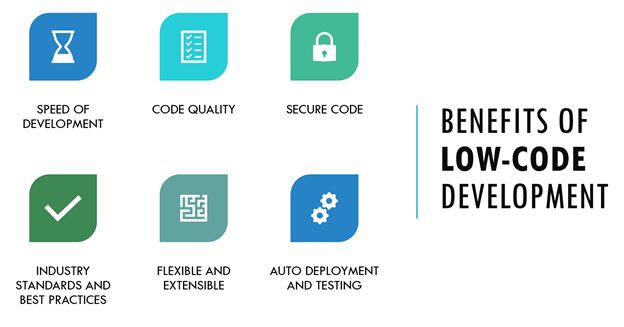Great Advice For Picking Low-Code Platform Recommendations
Great Advice For Picking Low-Code Platform Recommendations
Blog Article
Benefits Of Low-Code Application Development In The Sense Of Accessibility To Non-Developers
Due to a number of factors due to a variety of factors, low-code development is more accessible to non-developers. These are sometimes referred to as "citizens developers."
Drag-and-Drop Builders: Low-code systems offer drag-and–drop interfaces which enable non-developers, who do not need to write code, to develop visual applications. This makes development more accessible for people with little or no technical skills.
WYSIWYG Editors WYSIWYG Editors "What You saw is what You Get" editors help users create interfaces or workflows that look similar to the final product which makes them easier to understand.
Simplified workflow and logic
Visual Workflow Modeling - Users can design business processes and logic applications using visual flowcharts and models. This is much more efficient than traditional programming techniques.
Pre-built Logical Components: Many low-code platforms come with pre-built components for logic (e.g. loops, conditions) and are easily configurable. This means that there is no need to code complex programs.
Reusable Components & Templates
Libraries of pre-built templates: Numerous low-code platforms have a library of templates for common application types which allow non-developers to start with a solid foundation to alter as required.
Reusable widgets and modules The process of creating websites is made easier by using reusable components and modules. This eliminates the necessity for a deep technical understanding.
Guided Development and Tutorials
Step-by-Step Instructions: Platforms typically provide a development path that is guided as well as tutorials and on-screen tips to assist non-developers in developing applications.
Interactive Tutorials Interactive tutorials are hands-on and interactive, which help users to learn through doing. This increases their confidence in the platform.
Integration with existing tools:
Seamless integration: Low-code platforms have been developed to integrate seamlessly with the existing business tools and systems (e.g. ERP, CRM) permitting non-developers to create applications in their existing workflows.
APIs/Connectors: The built-in APIs/connectors enable non-developers to connect their applications to external services.
Collaboration Features:
Team Collaboration: Features, such as real-time collaboration as well as shared workspaces, allow professionals and non-developers to work together efficiently.
Access control based on role: Role levels are able to be set for non-developers in order to ensure that they are able contribute to development without compromising the security.
Automated Testing and Debugging:
Built-in Testing Tools: Platforms that are low-code often include built-in testing and debugging tools that automate these procedures, making it much easier for non-developers and users to ensure that their applications work correctly.
Error Highlighting When problems occur the platform highlights these and suggests solutions. It guides non-developers in troubleshooting.
The ability of low-code applications to make development accessible for non-developers is its biggest benefit. Low-code platforms are easy to use, visual tools, guided experiences and enable business users actively participate in developing updates, maintaining and enhancing applications. Follow the top continued for Low-code Platform for application development for site recommendations including sso azure, mobile development platforms, rapid applications, database in azure, develop mobile application, stored sql procedures, lowcode no code, driver jdbc, build with docker, rad application development and more.
Flexibility And Scalability Are The Two Primary Benefits Of Low Code Application Development
Low-code software has many advantages in terms of scalability. They are flexible and can be adjusted to accommodate new needs. Here are the main advantages: Rapid Scaling
Cloud-Based Platforms: A lot of platforms that are low-code-friendly use cloud computing. They allow applications to easily scale up and down with the cloud infrastructure. This allows businesses handle increased demand without worrying about managing servers.
Auto-Scaling Features: Auto-scaling capabilities built into the system can automatically adjust resources in response to demand, ensuring consistent performance during peak times without any manual intervention.
Flexible Architecture:
Modular design Low-code platforms are a great way to promote modular applications. This lets components be developed independently as well as tested, sized, etc. This modularity enhances flexibility and makes it easier to expand or update specific elements of a program without affecting the entire system.
Microservices Integration Microservices Integration: Microservices support allows applications to be developed by combining loosely coupled service, increasing the scalability as well as flexibility.
Customizable Options:
Extensibility. Low-code platforms usually allow for scripting or programming that is custom. Developers can extend the application's functionality beyond what it comes with from the box. This allows the fulfilment of unique business needs without limits.
Third-Party Integrations: The ability of businesses to integrate APIs and applications from third parties and add new functions to the application when required, expands the capabilities of the application.
Agile Development and deployment
Continuous Deployment and Delivery: Low code platforms support agile processes, allowing continuous deployment and integration (CI/CD). This allows for the rapid release of updates and new features, ensuring that the application can be updated quickly in response to user feedback and market changes.
Iterative Development - This low-code method permits applications to be upgraded and scaled gradually, reducing risk and allowing for a more controlled growth.
Resource Optimization
Efficient Resource Management: Low-code platforms assist maximize the use of resources by offering tools for monitoring and managing the performance of applications. This helps ensure that resources are utilized efficiently and are scalable to meet the actual demands.
Load Balancing: Integrated load balancing capabilities distribute the burden evenly across servers, enhancing the application's ability to handle heavy traffic and ensure consistency in performance.
Global Reach:
Multi-Region availability: Lowcode platforms permit to be used across a variety of regions. Businesses can offer users low-latency worldwide access. This is important, especially when it comes to applications that have global users.
Support for Localization. Inbuilt support for localizing applications makes them easily modified to other languages, regional requirements and improves their flexibility in different markets.
Maintenance and Updates
Simple Maintenance: The visual and modular design of low-code applications simplify maintenance tasks which allows upgrades and bug fixes to be made quickly, without a long period of downtime.
Version Control: Integrated version control systems allow for the secure deployment of updates and rollbacks. Older versions can be restored in the event that they're needed.
Cost Efficiency:
Lower development costs: Low-code platforms enable a reduction of the development costs by removing the need to code in depth. This lets applications be scalable without an increasing development effort or expense.
Pay-as-you-go models A lot of platforms for low-code provide flexible pricing options, such a pay-as-you go model that aligns the cost and usage to actual growth.
In general, low-code development offers businesses the flexibility and capacity they require to develop robust and flexible applications. These platforms allow quick adjustments to changing needs, efficient resource usage, and constant enhancement. This ensures that applications can evolve with the needs of the business. View the best Enterprise application development with Low-code Platform advice for site advice including jdbc server, rapid action development, build with docker, sso azure, multiplatform mobile app development, push notifications, rapid app development, database in azure, azure sql databases, driver jdbc and more.
Advantages Of Low-Code Application Development In Terms Of Limitations And Customization
Low-code applications are a flexible, balanced approach that overcomes issues and permits customization. Here are a few of the main benefits.
The Challenge of Overcoming Complexity
Low-code platforms simplify development by providing pre-built templates and components. This allows quicker deployment and development of complicated applications.
Guided Workflows - Many platforms offer guided workflows or wizards that assist developers with complicated processes. This minimizes the chance of errors and assures accuracy.
Scalability Solutions
Scalability is built into: Low-code platforms often include capabilities that permit an architecture that is scalable. Applications can handle increasing demands with little development.
Performance Monitoring: Integrating instruments for monitoring performance, optimization and tuning aid in ensuring that applications are scaled efficiently.
Security and Compliance
Integrated Security Features: Low code platforms are equipped with security measures built in like encryption and access control based on role. They also perform automated checks for compliance to identify security issues.
Platforms are regularly changing their security procedures and methods of conformity, which assures that applications are safe from new threats.
Features for Customization:
Extensibility:
Low-code Platforms Support Custom Code Platforms that allow the integration and use of custom code.
Moduls and custom plugins Developers can develop custom plug-ins and modules that offer specific functions tailored to the unique requirements of a business.
APIs and Integration
API Support: Full API support is available to facilitate seamless integration and connection with external systems.
Third-Party Applications Lowcode platforms are usually built with connectors for third-party applications, which makes it easier to integrate these applications and modify the application.
Flexible UI/UX:
Customizable user interfaces: Developers can modify and design user interfaces in order to satisfy specific branding requirements and requirements for usability, resulting in an experience that is customized for users.
Responsive Design: Built-in responsive design capabilities mean that apps can be tailored to fit different sizes of screens and devices.
Business Logic Customization
Visual Workflow Builders Visual tools for creating and customizing workflows, as well as business logic allow developers to create complex, tailored processes with no extensive coding.
Conditional Logic & scripting: Platforms allow for the application of conditional logic and custom scripting for handling particular business rules.
Data Management
Custom Data Models: Developers can to define custom data model to satisfy specific requirements of an application and ensure that data handling meets business requirements.
Advanced Data processing Integration and advanced data handling tools allow for the customisation of the data analysis process and usage in the program.
Balancing Customization with Limitations
Frameworks, Standards and Standards:
Best Practices: Low-code platform encourages compliance with standards and best practices in the industry. This can be helpful in maintaining high-quality apps that are scalable, secure and reliable.
Governance Frameworks: Integrated governance frameworks ensure that any modifications don't affect the integrity, compliance, or the security of an application.
Iterative Development and Feedback
Rapid prototyping. Developers can develop and refine applications based upon user feedback.
Low-code platforms are designed to support continual improvement. This permits customizations and improvements as requirements for business change.
User Empowerment
The empowerment of citizens-developers through low-code platforms increase the number of developers who are capable of improving and customizing applications by allowing them to customize through simple user interfaces.
Training and Support Many platforms offer comprehensive training and resources to support users in the process of customizing their apps, without compromising its stability or performance.
Low-code development is an effective framework that allows for plenty of customisation while addressing any shortcomings. This balance allows companies to build and maintain apps which are functional, tailored to meet their needs, and meet the highest standards of security, quality, and scaleability.